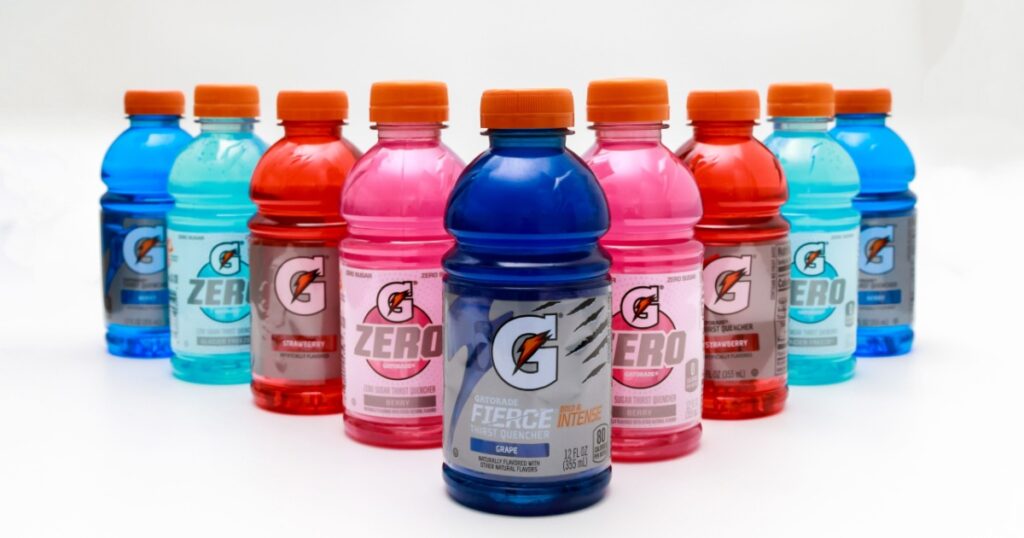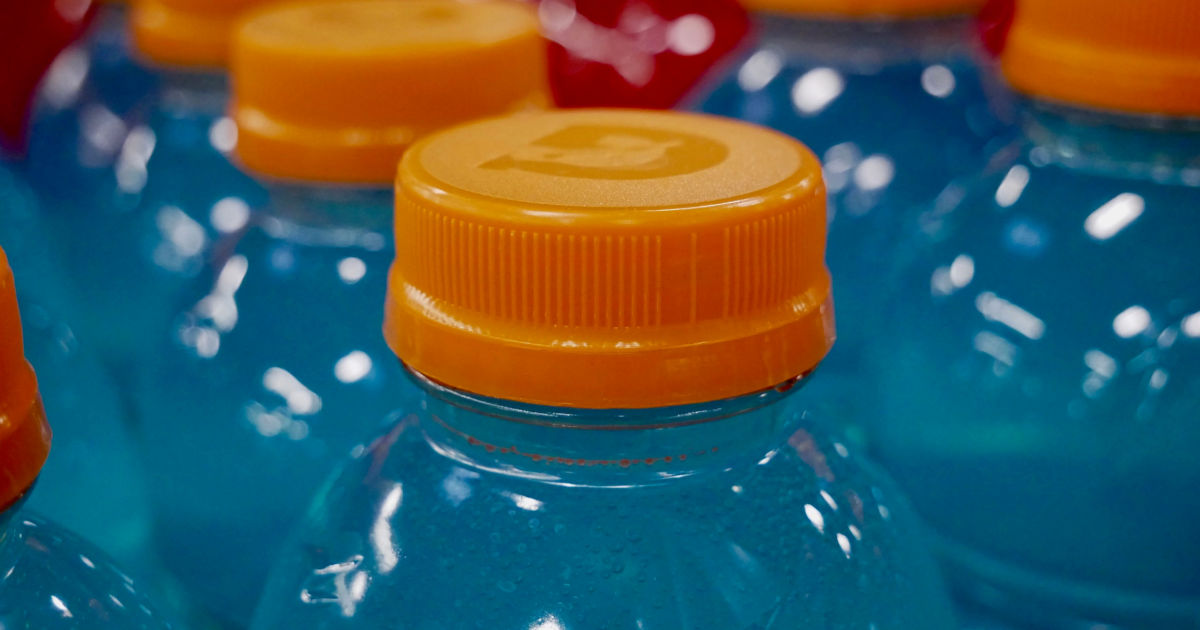Gatorade is a popular sports drink that offers various beverage lines, each with its own unique characteristics. However, the ingredients found in Gatorade, such as sugars, dyes, and other additives, raise concerns about potential harm to health. Let’s explore the composition of Gatorade, its drawbacks, and alternative options that promote better health.
Understanding Gatorade’s Ingredients

Gatorade now has many different beverage lines, including the original, Flow, Fierce, Frost, G Organic, G2 (with half the sugar), and Zero (no sugar). Aside from the varying sugar content and flavor intensity, these drinks share a similar makeup of electrolytes, flavors, dyes, and other ingredients.
Read More: 28 Drinks Recalled Over Chemical Exposure, FDA Report
Here’s a breakdown of what’s in a typical bottle as well as the intended purposes of these basic ingredients:

- Water, for fluid to help hydrate
- Sugar, for fuel
- Dextrose, another type of sugar added to fuel
- Citric acid, for flavor
- Salt, for electrolyte replenishment
- Sodium citrate, the sodium salt of citric acid to improve the flavor
- Monopotassium phosphate, adds potassium for electrolyte replacement
- Modified food starch, stabilizing agent
- Natural flavor, for flavor
- Food dyes, for color
- Glycerol ester of rosin, stabilizing agent
- Caramel color, and food coloring, used in some products
One exception is the G Organic drinks which are certified organic and only contain seven ingredients: water, cane sugar, citric acid, natural flavor, sea salt, sodium citrate, and potassium chloride.
Concerns Regarding Food Dyes

Gatorade’s vibrant colors are achieved through the use of food dyes, such as Red 40 and Yellow 5. Some individuals question the safety of these dyes, fearing potential risks like cancer or hyperactivity. However, the FDA has conducted reviews and determined that the food colors used in Gatorade are safe for consumption. For those who wish to avoid artificial colors, the G Organic line offers a dye-free alternative.
These artificial colors are banned in foods for infants and children in the European Union, and they must also carry warnings on all other products there. They are also completely banned in Norway and Austria. Studies have also linked dyes to allergies, hyperactivity, aggressive tendencies, and irritability in children. A British study conducted in 2007 revealed that kids who ate a combination of common synthetic dyes exhibited hyperactive behavior within one hour.
With growing frequency, parents are noting a connection between their children’s behavior and their consumption of food containing synthetic dyes — namely, red #3, red #40, and yellow #5. In recent years, more than 2,000 parents have reported their concerns to the Center for Science in the Public Interest (CSPI), a consumer advocacy group. “We’re a non-profit organization and somehow people manage to find us,” says Lisa Lefferts, MSPH, a senior scientist with CSPI, which has petitioned the U.S. Food and Drug Administration (FDA) to ban these food dyes. “The stories are heartbreaking.”
The Sugar Debate

One prominent criticism of Gatorade is its high sugar content. A standard 20-ounce bottle of Gatorade Original Thirst Quencher contains 36 grams of carbohydrate, nearly as much as a 12-ounce can of soda or as much added sugar as there is in 13 Hershey’s Chocolate Kisses. While sugar can be beneficial during prolonged exercise, providing quick energy, excessive consumption can be problematic. This issue primarily affects individuals who regularly consume Gatorade without engaging in intense or extended physical activity. Consuming such a large amount of refined sugar can have negative effects on your health, including weight gain, and increased risk of chronic diseases such as diabetes, and tooth decay.
Drawbacks of Excessive Gatorade Consumption

Regular consumption of Gatorade, particularly among individuals who do not engage in intense physical activity, can lead to various health issues. Here are a few drawbacks to consider:
- Dental Problems: The acid in sports drinks can erode tooth enamel, while the sugars contribute to tooth decay and cavities.
- Behavioral Issues: Artificial food colors, including those used in Gatorade, have been associated with exacerbating behavioral problems in individuals with ADHD. However, more research is needed to establish a definitive link.
- Weight Gain: Some studies suggest a small increase in body mass index (BMI) among children who regularly consume sugar-sweetened beverages. It’s important to note that BMI is an imperfect measure that does not account for various factors.
Read More: 9 of The Best Foods and Drinks for Liver Health
Exploring Healthy Alternatives

Fortunately, there are numerous natural and healthier alternatives to Gatorade that offer electrolyte replacement and additional health benefits. Here are a few options to consider:
- Coconut Water: This natural source of electrolytes is not only hydrating but also rich in antioxidants and cytokinins, which have anti-aging and anticancer properties. Studies have shown that coconut water can be just as effective as commercial sports drinks in rehydrating athletes. A study published in the Journal of the International Society of Sports Nutrition compared the effectiveness of coconut water and a commercial sports drink in rehydrating athletes, highlighting coconut water as a viable option.
- Watermelon: With its high water content and electrolyte-rich composition, watermelon is an excellent choice for hydration and replenishing essential minerals. It also contains lycopene, a potent antioxidant that supports heart health and may help protect against certain cancers. Research published in the Journal of Agricultural and Food Chemistry explored the impact of watermelon juice on exercise performance and muscle soreness in athletes, providing evidence of its potential benefits.
- Homemade Electrolyte Replacement Recipe: For those who prefer homemade options, creating your own electrolyte replacement drink is a simple and cost-effective solution. Here’s a recipe that combines natural ingredients to provide essential electrolytes:Ingredients:
- 2 cups of coconut water
- 1/4 cup of freshly squeezed lemon juice
- 1/4 teaspoon of sea salt
- 2 tablespoons of honey or maple syrup (optional for added sweetness)
Instructions:

- In a pitcher, combine the coconut water and lemon juice.
- Stir in the sea salt and optional sweetener until well combined.
- Chill the mixture in the refrigerator for at least 30 minutes to allow the flavors to meld together.
- Serve the homemade electrolyte drink cold and enjoy it as needed for hydration and electrolyte replenishment.
Other Alternatives and Health Benefits

In addition to coconut water and watermelon, there are several other natural options for electrolyte replacement. These include
- Homemade Fruit Infused Water: Infusing water with slices of fruits like oranges, berries, or cucumbers can add a subtle flavor while providing essential electrolytes and hydration.
- Herbal Teas: Certain herbal teas, such as chamomile or ginger tea, can have soothing properties and offer electrolytes and hydration.
- Chia Seeds: Adding chia seeds to water or other beverages creates a gel-like consistency, providing hydration and electrolytes. Chia seeds are also rich in fiber and omega-3 fatty acids.
While Gatorade may be a popular choice for hydration and electrolyte replenishment, its high sugar content, artificial additives, and potential drawbacks raise concerns about its impact on health. By considering healthier alternatives like coconut water and watermelon, individuals can enjoy the benefits of natural electrolyte replacement while also gaining additional nutritional advantages. Creating homemade electrolyte drinks is another excellent option, allowing for customization and control over ingredients. Prioritizing hydration and overall well-being is essential, and with the comprehensive information provided, readers can make informed choices for optimal health.
Read More: 15 Women’s Health Myths That Can Be Harmful

